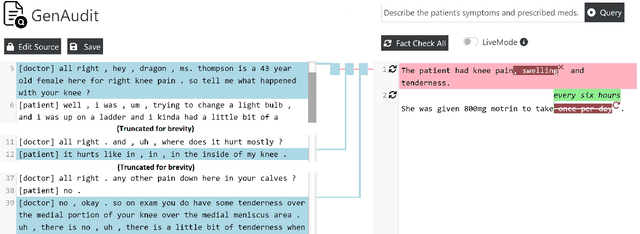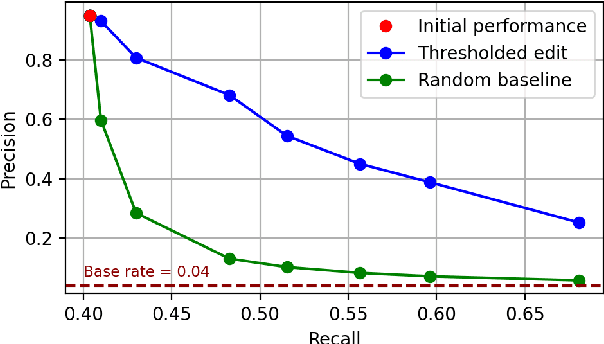Jeffrey P. Bigham
StepWrite: Adaptive Planning for Speech-Driven Text Generation
Aug 06, 2025



Abstract:People frequently use speech-to-text systems to compose short texts with voice. However, current voice-based interfaces struggle to support composing more detailed, contextually complex texts, especially in scenarios where users are on the move and cannot visually track progress. Longer-form communication, such as composing structured emails or thoughtful responses, requires persistent context tracking, structured guidance, and adaptability to evolving user intentions--capabilities that conventional dictation tools and voice assistants do not support. We introduce StepWrite, a large language model-driven voice-based interaction system that augments human writing ability by enabling structured, hands-free and eyes-free composition of longer-form texts while on the move. StepWrite decomposes the writing process into manageable subtasks and sequentially guides users with contextually-aware non-visual audio prompts. StepWrite reduces cognitive load by offloading the context-tracking and adaptive planning tasks to the models. Unlike baseline methods like standard dictation features (e.g., Microsoft Word) and conversational voice assistants (e.g., ChatGPT Advanced Voice Mode), StepWrite dynamically adapts its prompts based on the evolving context and user intent, and provides coherent guidance without compromising user autonomy. An empirical evaluation with 25 participants engaging in mobile or stationary hands-occupied activities demonstrated that StepWrite significantly reduces cognitive load, improves usability and user satisfaction compared to baseline methods. Technical evaluations further confirmed StepWrite's capability in dynamic contextual prompt generation, accurate tone alignment, and effective fact checking. This work highlights the potential of structured, context-aware voice interactions in enhancing hands-free and eye-free communication in everyday multitasking scenarios.
CowPilot: A Framework for Autonomous and Human-Agent Collaborative Web Navigation
Jan 28, 2025



Abstract:While much work on web agents emphasizes the promise of autonomously performing tasks on behalf of users, in reality, agents often fall short on complex tasks in real-world contexts and modeling user preference. This presents an opportunity for humans to collaborate with the agent and leverage the agent's capabilities effectively. We propose CowPilot, a framework supporting autonomous as well as human-agent collaborative web navigation, and evaluation across task success and task efficiency. CowPilot reduces the number of steps humans need to perform by allowing agents to propose next steps, while users are able to pause, reject, or take alternative actions. During execution, users can interleave their actions with the agent by overriding suggestions or resuming agent control when needed. We conducted case studies on five common websites and found that the human-agent collaborative mode achieves the highest success rate of 95% while requiring humans to perform only 15.2% of the total steps. Even with human interventions during task execution, the agent successfully drives up to half of task success on its own. CowPilot can serve as a useful tool for data collection and agent evaluation across websites, which we believe will enable research in how users and agents can work together. Video demonstrations are available at https://oaishi.github.io/cowpilot.html
AI Policy Projector: Grounding LLM Policy Design in Iterative Mapmaking
Sep 26, 2024Abstract:Whether a large language model policy is an explicit constitution or an implicit reward model, it is challenging to assess coverage over the unbounded set of real-world situations that a policy must contend with. We introduce an AI policy design process inspired by mapmaking, which has developed tactics for visualizing and iterating on maps even when full coverage is not possible. With Policy Projector, policy designers can survey the landscape of model input-output pairs, define custom regions (e.g., "violence"), and navigate these regions with rules that can be applied to LLM outputs (e.g., if output contains "violence" and "graphic details," then rewrite without "graphic details"). Policy Projector supports interactive policy authoring using LLM classification and steering and a map visualization reflecting the policy designer's work. In an evaluation with 12 AI safety experts, our system helps policy designers to address problematic model behaviors extending beyond an existing, comprehensive harm taxonomy.
Towards Bidirectional Human-AI Alignment: A Systematic Review for Clarifications, Framework, and Future Directions
Jun 17, 2024Abstract:Recent advancements in general-purpose AI have highlighted the importance of guiding AI systems towards the intended goals, ethical principles, and values of individuals and groups, a concept broadly recognized as alignment. However, the lack of clarified definitions and scopes of human-AI alignment poses a significant obstacle, hampering collaborative efforts across research domains to achieve this alignment. In particular, ML- and philosophy-oriented alignment research often views AI alignment as a static, unidirectional process (i.e., aiming to ensure that AI systems' objectives match humans) rather than an ongoing, mutual alignment problem [429]. This perspective largely neglects the long-term interaction and dynamic changes of alignment. To understand these gaps, we introduce a systematic review of over 400 papers published between 2019 and January 2024, spanning multiple domains such as Human-Computer Interaction (HCI), Natural Language Processing (NLP), Machine Learning (ML), and others. We characterize, define and scope human-AI alignment. From this, we present a conceptual framework of "Bidirectional Human-AI Alignment" to organize the literature from a human-centered perspective. This framework encompasses both 1) conventional studies of aligning AI to humans that ensures AI produces the intended outcomes determined by humans, and 2) a proposed concept of aligning humans to AI, which aims to help individuals and society adjust to AI advancements both cognitively and behaviorally. Additionally, we articulate the key findings derived from literature analysis, including discussions about human values, interaction techniques, and evaluations. To pave the way for future studies, we envision three key challenges for future directions and propose examples of potential future solutions.
UICoder: Finetuning Large Language Models to Generate User Interface Code through Automated Feedback
Jun 11, 2024Abstract:Large language models (LLMs) struggle to consistently generate UI code that compiles and produces visually relevant designs. Existing approaches to improve generation rely on expensive human feedback or distilling a proprietary model. In this paper, we explore the use of automated feedback (compilers and multi-modal models) to guide LLMs to generate high-quality UI code. Our method starts with an existing LLM and iteratively produces improved models by self-generating a large synthetic dataset using an original model, applying automated tools to aggressively filter, score, and de-duplicate the data into a refined higher quality dataset. The original LLM is improved by finetuning on this refined dataset. We applied our approach to several open-source LLMs and compared the resulting performance to baseline models with both automated metrics and human preferences. Our evaluation shows the resulting models outperform all other downloadable baselines and approach the performance of larger proprietary models.
"This really lets us see the entire world:" Designing a conversational telepresence robot for homebound older adults
May 23, 2024



Abstract:In this paper, we explore the design and use of conversational telepresence robots to help homebound older adults interact with the external world. An initial needfinding study (N=8) using video vignettes revealed older adults' experiential needs for robot-mediated remote experiences such as exploration, reminiscence and social participation. We then designed a prototype system to support these goals and conducted a technology probe study (N=11) to garner a deeper understanding of user preferences for remote experiences. The study revealed user interactive patterns in each desired experience, highlighting the need of robot guidance, social engagements with the robot and the remote bystanders. Our work identifies a novel design space where conversational telepresence robots can be used to foster meaningful interactions in the remote physical environment. We offer design insights into the robot's proactive role in providing guidance and using dialogue to create personalized, contextualized and meaningful experiences.
UIClip: A Data-driven Model for Assessing User Interface Design
Apr 18, 2024Abstract:User interface (UI) design is a difficult yet important task for ensuring the usability, accessibility, and aesthetic qualities of applications. In our paper, we develop a machine-learned model, UIClip, for assessing the design quality and visual relevance of a UI given its screenshot and natural language description. To train UIClip, we used a combination of automated crawling, synthetic augmentation, and human ratings to construct a large-scale dataset of UIs, collated by description and ranked by design quality. Through training on the dataset, UIClip implicitly learns properties of good and bad designs by i) assigning a numerical score that represents a UI design's relevance and quality and ii) providing design suggestions. In an evaluation that compared the outputs of UIClip and other baselines to UIs rated by 12 human designers, we found that UIClip achieved the highest agreement with ground-truth rankings. Finally, we present three example applications that demonstrate how UIClip can facilitate downstream applications that rely on instantaneous assessment of UI design quality: i) UI code generation, ii) UI design tips generation, and iii) quality-aware UI example search.
Deconstructing the Veneer of Simplicity: Co-Designing Introductory Generative AI Workshops with Local Entrepreneurs
Feb 26, 2024Abstract:Generative AI platforms and features are permeating many aspects of work. Entrepreneurs from lean economies in particular are well positioned to outsource tasks to generative AI given limited resources. In this paper, we work to address a growing disparity in use of these technologies by building on a four-year partnership with a local entrepreneurial hub dedicated to equity in tech and entrepreneurship. Together, we co-designed an interactive workshops series aimed to onboard local entrepreneurs to generative AI platforms. Alongside four community-driven and iterative workshops with entrepreneurs across five months, we conducted interviews with 15 local entrepreneurs and community providers. We detail the importance of communal and supportive exposure to generative AI tools for local entrepreneurs, scaffolding actionable use (and supporting non-use), demystifying generative AI technologies by emphasizing entrepreneurial power, while simultaneously deconstructing the veneer of simplicity to address the many operational skills needed for successful application.
GenAudit: Fixing Factual Errors in Language Model Outputs with Evidence
Feb 19, 2024



Abstract:LLMs can generate factually incorrect statements even when provided access to reference documents. Such errors can be dangerous in high-stakes applications (e.g., document-grounded QA for healthcare or finance). We present GenAudit -- a tool intended to assist fact-checking LLM responses for document-grounded tasks. GenAudit suggests edits to the LLM response by revising or removing claims that are not supported by the reference document, and also presents evidence from the reference for facts that do appear to have support. We train models to execute these tasks, and design an interactive interface to present suggested edits and evidence to users. Comprehensive evaluation by human raters shows that GenAudit can detect errors in 8 different LLM outputs when summarizing documents from diverse domains. To ensure that most errors are flagged by the system, we propose a method that can increase the error recall while minimizing impact on precision. We will release our tool (GenAudit) and fact-checking model for public use.
"What's important here?": Opportunities and Challenges of Using LLMs in Retrieving Information from Web Interfaces
Dec 11, 2023Abstract:Large language models (LLMs) that have been trained on a corpus that includes large amount of code exhibit a remarkable ability to understand HTML code. As web interfaces are primarily constructed using HTML, we design an in-depth study to see how LLMs can be used to retrieve and locate important elements for a user given query (i.e. task description) in a web interface. In contrast with prior works, which primarily focused on autonomous web navigation, we decompose the problem as an even atomic operation - Can LLMs identify the important information in the web page for a user given query? This decomposition enables us to scrutinize the current capabilities of LLMs and uncover the opportunities and challenges they present. Our empirical experiments show that while LLMs exhibit a reasonable level of performance in retrieving important UI elements, there is still a substantial room for improvement. We hope our investigation will inspire follow-up works in overcoming the current challenges in this domain.
 Add to Chrome
Add to Chrome Add to Firefox
Add to Firefox Add to Edge
Add to Edge